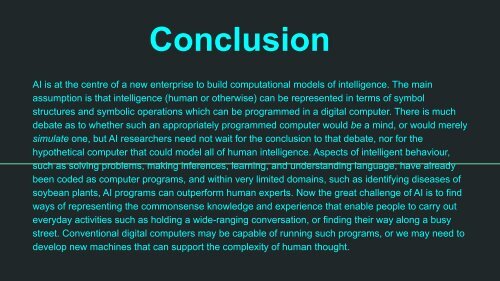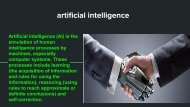ppt submission
You also want an ePaper? Increase the reach of your titles
YUMPU automatically turns print PDFs into web optimized ePapers that Google loves.
Conclusion<br />
AI is at the centre of a new enterprise to build computational models of intelligence. The main<br />
assumption is that intelligence (human or otherwise) can be represented in terms of symbol<br />
structures and symbolic operations which can be programmed in a digital computer. There is much<br />
debate as to whether such an appropriately programmed computer would be a mind, or would merely<br />
simulate one, but AI researchers need not wait for the conclusion to that debate, nor for the<br />
hypothetical computer that could model all of human intelligence. Aspects of intelligent behaviour,<br />
such as solving problems, making inferences, learning, and understanding language, have already<br />
been coded as computer programs, and within very limited domains, such as identifying diseases of<br />
soybean plants, AI programs can outperform human experts. Now the great challenge of AI is to find<br />
ways of representing the commonsense knowledge and experience that enable people to carry out<br />
everyday activities such as holding a wide-ranging conversation, or finding their way along a busy<br />
street. Conventional digital computers may be capable of running such programs, or we may need to<br />
develop new machines that can support the complexity of human thought.





